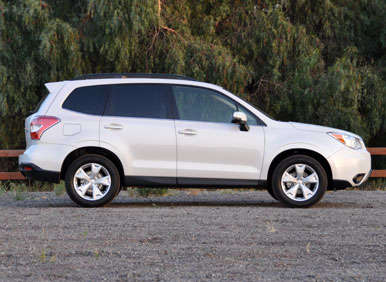Recent Articles
Popular Makes
Body Types
2014 Subaru Forester Road Test and Review
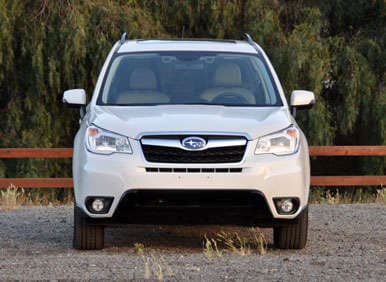
There’s a new 2014 Subaru Forester in town, but you might not have noticed it. Completely redesigned, the 2014 Forester adheres to a tried-and-true crossover SUV formula that blends room for five people with Subaru hallmarks including a boxer-type 4-cylinder engine, standard all-wheel drive, plenty of ground clearance, quirky styling, and an underlying Ring-Shaped Reinforcement Frame structure engineered to keep everyone aboard safe and sound.
This is not to say that Subaru hasn’t improved the new 2014 Forester. This year, the popular crossover is longer, wider, and bigger inside than ever, and is rated to get better fuel economy. The all-wheel-drive system is upgraded, a new continuously variable transmission (CVT) debuts, and the optional turbocharged engine is more powerful than before. New safety and connectivity technologies are also on the menu.
To see how well the new Forester might compete against a slew of other compact crossover SUVs, especially heavy hitters like the Chevrolet Equinox, Ford Escape, Honda CR-V, and Toyota RAV4, I borrowed one for a week of daily-driver family duty. As it turns out, there are plenty of reasons to recommend the redesigned 2014 Subaru Forester, and a couple of reasons not to.
2014 Subaru Forester Road Test and Review: Models and Prices
Subaru offers the 2014 Forester in two model series: 2.5i and 2.0XT. The Forester 2.0XT is equipped with a turbocharged engine, a unique CVT, Subaru Intelligent Drive (SI-Drive), a sport-tuned suspension, more robust brakes, and bigger wheels and tires. This review does not cover the Forester 2.0XT model.
Rather, we’re here to talk about the mainstream version of the new Forester, the 2.5i. Four trim levels are available, starting with the standard Forester 2.5i ($22,820 including the $825 destination charge). Upgrades include the Forester 2.5i Premium ($24,320), the Forester 2.5i Limited ($28,820), and the Forester 2.5i Touring ($30,820).
My Satin White Pearl test model is the 2.5i Touring equipped with Keyless Access and Start technology, high intensity-discharge headlights, and Subaru’s EyeSight system, which employs stereo cameras mounted on the inside of the windshield and behind the rearview mirror to provide adaptive cruise control, a lane departure warning system, and a pre-collision braking system. The final price tag for my test vehicle was $33,220.
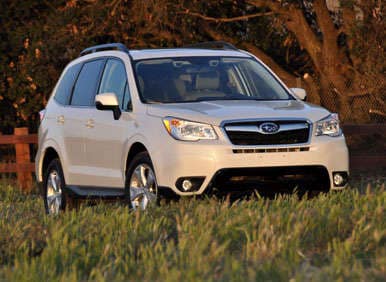
2014 Subaru Forester Road Test and Review: Design
- Exterior styling
- Standard 17-inch wheels
- Redesigned interior
With this redesign, the Subaru Forester grows in size, longer and wider than the previous-generation version, and equipped with doors that open wider than before. A power rear liftgate is available, and can be set to open to varying heights to help reduce damage associated with low parking garage ceilings.
In my opinion, the new Forester is better looking than the old one. That is not to say, however, that it is attractive. Like all Subarus – yes, even the BRZ – the Forester possesses an endearing homeliness that lends it a distinctive, quirky, and appealing personality. The vibe here is all function, no fashion. And that’s just how Subaru buyers like it.
The interior matches the practical themes established by the exterior design. Though my test vehicle was the top-of-the-line model equipped with perforated leather seats and a two-tone color scheme, it didn’t feel like a luxurious conveyance. Despite a soft-touch one-piece upper dashboard, my Forester’s cabin was loaded with hard gray plastic, silver trim that did a poor job of imitating metal, and a headliner that looked and felt like it might be constructed of recycled cardboard. Better to have used the same material wrapped around the sun visors for the headliner, Subaru. Add certain comfort problems and a touchscreen infotainment system that looks half a decade old, and Forester buyers might have a hard time accepting a window sticker that starts with a three.
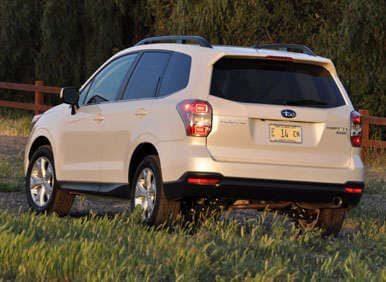
2014 Subaru Forester Road Test and Review: Comfort and Cargo
- Seats are raised to a higher position
- Door sills are lower for easier entry and exit
- Improved rear seat legroom
- Wider interior with true 5-passenger seating
- Larger cargo area
- Power liftgate option
On the previous page, I alluded to comfort problems with the new Forester. I was talking about the places where the driver rests his or her appendages, specifically the center console armrest, the upper door panel, and the jutting door panel pod that houses the power window and mirror controls.
The center console armrest, which slides forward for added comfort, is insufficiently padded. If the driver or front passenger leans on it, their elbow painfully contacts the hard plastic that forms its basis. While it’s nice that the upper dashboard is soft, nobody touches that part of the car. Better would be to place soft material on the top portion of the door panel, and use low-gloss plastic with a rubbery coating for the upper dashboard. Finally, the plastic housing that contains the power window and power mirror controls painfully jabbed into my left knee on a regular basis. It should be relocated, reshaped, or padded.
In addition to including larger doors that open wider, Subaru gives the new Forester a lower step-in height. As a result, getting into and out of this crossover is exceptionally easy. The supportive front seats, which sit high off the floor, and the leather-wrapped steering wheel, which is properly sized and shaped and is pleasing to grip, provide excellent comfort. The rear seat cushion is a little too soft and is mounted a little too low for my preferences, but there’s no denying that the Forester’s back seat offers plenty of legroom and space for feet under the front seats. Kids in forward-facing child seats will find it difficult to kick the front seatbacks, a blessing to parents of smaller children.
Equipped with more cargo space than before, the new Forester can hold a substantial 34.4 cu.-ft. of luggage behind the rear seat. Fold the rear seat down, and it swallows 74.7 cu.-ft. of stuff, more than a CR-V or RAV4, direct competitors that are among the most commodious vehicles in the class for carrying cargo.
Visibility is no problem with the 2014 Forester, and not because of the optional Eyesight technology. Thanks to a tall seating position, a low dashboard, an enormous windshield, and thin windshield pillars, the driver enjoys a panoramic view of the world. Add the gigantic sunroof, and the effect is like a front-row seat in an iMax theatre.
Strangely, though, the Forester’s sunroof glass lacks tint, and with the cover retracted the glare and additional cabin heating are significant irritants, even while wearing sunglasses. Subaru, why provide such a large window to the world and then make it unpleasant to sit beneath it?
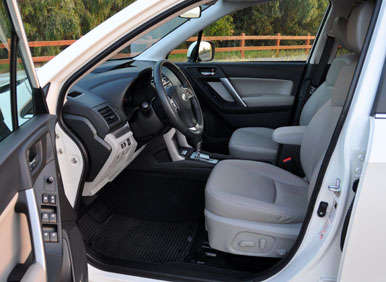
2014 Subaru Forester Road Test and Review: Features and Controls
- Standard Bluetooth connectivity and audio streaming
- Optional Keyless Access and Start technology
- New infotainment options, including Aha smartphone integration
Drivers will have no trouble finding what they’re looking for inside of the 2014 Forester, unless what they’re looking for is the switch that shuts the stability control system off. That’s hidden down on the lower left side of the dashboard, along with the redundant manual liftgate opener.
From my perspective, the biggest problem with the Forester’s controls is the 6.1-inch touchscreen display that is included for the Premium, Limited and Touring models when equipped with the optional navigation system. The good news is that a single knob controls power and volume, and there are three buttons used to activate the audio menu, the navigation map, and the voice command system. That part is easy. What makes me feel obtuse is when I’m trying to discern detail on a small screen crammed with detail and suffering significant glare and reflection. As a result, using the screen produces significant distraction, prompting me to recommend that Subaru require Eyesight technology as a pre-requisite to purchasing the navigation system. Those drivers are gonna need it.
Gratefully, the Forester’s reversing camera, standard on the Premium, Limited, and Touring trim levels, does not require the navigation system’s screen. Instead, an image of what’s behind the Forester appears on the 4.3-inch information display at the top of the dashboard, which offers a variety of information and pleasing graphics that are easy to see and read no matter the time of day.
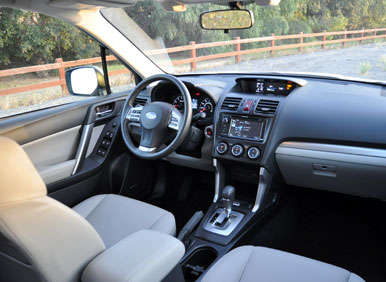
2014 Subaru Forester Road Test and Review: Safety and Ratings
- Anti-whiplash front seat designs
- Knee airbag for the driver
- Brake Override system
- Fuel system cutoff following an impact
- Reversing camera standard for all except base model
- Optional EyeSight system with adaptive cruise control, lane departure warning, and pre-collision braking system
All Foresters have what Subaru calls its Ring-Shaped Reinforcement Frame design, which is engineered to deflect crash energy away from the occupant compartment. A new Brake Override system makes it impossible to accelerate if the brake pedal is pressed. In addition to these new standard safety features, the 2014 Forester offers safety-related upgrades as buyers move up the trim level ladder. A reversing camera is standard for the 2.5i Premium model, while the 2.5i Limited is equipped with standard Hill Descent Control and automatic headlights.
The 2.5i Touring is exclusively offered with Subaru’s new EyeSight technology, which is bundled in a package that includes Keyless Access and Start as well as high intensity discharge headlights. EyeSight uses two “stereo” cameras mounted inside the windshield behind the rearview mirror, and powers an adaptive cruise control system, a lane departure warning system, and a pre-collision braking system.
The Insurance Institute for Highway Safety (IIHS) calls the 2014 Forester a “Top Safety Pick,” but has not subjected the crossover to its new small overlap frontal-impact test. The National Highway Traffic Safety Administration (NHTSA) has not performed crash tests on the redesigned Forester as this review is written.
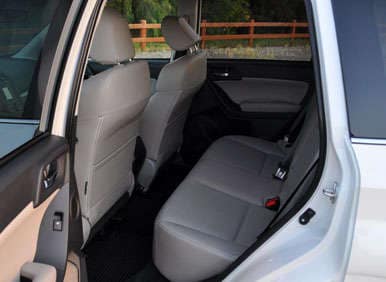
2014 Subaru Forester Road Test and Review: Engines and Fuel Economy
- Electric steering
- 6-speed manual gearbox replaces 5-speed unit
- CVT replaces 4-speed automatic transmission
- Active Torque Split AWD system with Hill Descent Control and X-Mode setting
The 2014 Forester 2.5i models are equipped with a 2.5-liter 4-cylinder engine generating 170 horsepower at 5,800 rpm and 174 lb.-ft. of torque at 4,100 rpm. The engine, which debuted in 2011 and is carried over from the previous Forester model, has horizontally opposed cylinders containing pistons that move laterally rather than vertically and, as a result, this type of engine is known as a “boxer” engine, or a “flat” engine.
Subaru and Porsche are the only car companies that engineer these types of engines, which typically afford a lower center of gravity and better handling in exchange for some extra characteristic grumble. An additional benefit to Subaru for using boxer engines is that the company can lower a vehicle’s center of gravity while simultaneously increasing ground clearance, and the Forester boasts 8.7 inches of distance from the lowest point on the underside of the vehicle to the ground.
A 6-speed manual gearbox and Incline Start Assist are standard for base and Premium trim levels, while the Limited and Touring trim levels include a continuously variable transmission (CVT). Get the manual gearbox, and the Forester’s all-wheel-drive system employs a viscous-coupling locking center differential that splits power evenly between the front and rear wheels, and then varies power delivery as traction conditions warrant. Get the CVT, and Subaru’s Active Torque Split AWD delivers the majority of engine power to the front wheels until such time as transfer to the rear wheels is necessary.
In addition to its front-drive bias, the Forester’s Active Torque Split AWD system includes a Hill Descent Control system, an X-Mode off-road traction system, and a torque-vectoring effect when the crossover is cornering.
My test vehicle had the CVT and the Active Torque Split AWD system. According to the EPA, it should have returned 24 mpg in the city, 32 mpg on the highway, and 27 mpg in combined driving. With an emphasis on highway driving, my test vehicle averaged 26.1 mpg.
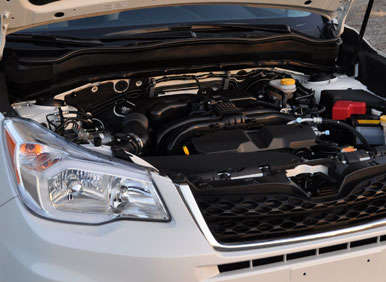
2014 Subaru Forester Road Test and Review: Driving Impressions
Traditionally, I enjoy driving Subarus. From their grumbling boxer engines to their rally-influenced handling, Subarus exude dynamic character and competence, rain or shine, on pavement or in the dirt. And if you ever need to do battle with a blizzard, you’d be hard pressed to find a better weapon than a Subaru.
Recent experience with the Impreza, however, had me concerned. That car’s new 2.0-liter 4-cylinder engine is either too refined or too isolated from the cabin, and the continuously variable transmission’s (CVT) drone robs the Impreza of its signature characteristic grumble.
Thankfully, the Forester 2.5i’s carryover 2.5-liter engine hasn’t been silenced by the addition of a CVT. Furthermore, the CVT is refined instead of raucous, calibrated to provide healthy off-the-line acceleration combined with mid-range response that makes passing easy and climbing mountain grades easier. As a result, the 3,296-lb. Forester feels stronger than its horsepower and torque figures might suggest.
Subaru delivers a good blend of ride comfort and contact patch communication with the Forester’s MacPherson strut front and double wishbone rear suspension. My test vehicle rode on 17-inch aluminum wheels wearing Yokohama Geolandar P225/60R17 mud-and-snow all-season tires, which proved equally competent on mountain trails and the twisty 2-lane roads leading to them.
In the dirt, the Forester offered enough ground clearance and wheel articulation to travel just about anywhere a novice off-roader might dare tread. On blacktop, the Forester proved adept at hustling through S-curves with a minimum of drama. The crossover’s brakes also withstood repeated abuse without fading, the pedal feeling natural underfoot at all times. This is a fun, tossable, and connected crossover SUV, no matter the type of road traveled.
Dynamically, the single criticism I offer relates to the Forester’s electric steering, which frequently feels heavy and leaden rather than light and lively. The Active Torque Split AWD system’s torque-vectoring effect doesn’t help, occasionally making the steering feel as though it is resisting input or wavering under acceleration. On a positive note, when driving the Forester down the freeway, it tracks resolutely, the wheel feeling firmly centered within the driver’s hands.
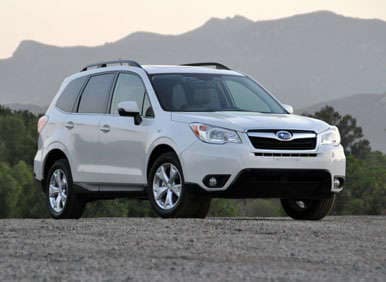
2014 Subaru Forester Road Test and Review: Final Thoughts
If any deal-breakers exist with the redesigned 2014 Forester, they pertain to the awful touchscreen that accompanies the optional navigation system, and to the uncomfortable center armrest, the hard plastic upper door panels, and the kneecap-killing power window pods on the door panels. Otherwise, the new Forester is an impressive little crossover SUV, eminently practical and easily affordable for a family, and one of my favorites in a popular segment.
Now I just need to get my hands on the turbocharged version.
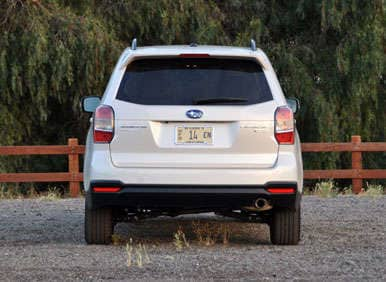
2014 Subaru Forester Road Test and Review: Pros and Cons
- Comfortable front seats
- Roomy back seat
- Lots of cargo space
- Excellent outward visibility
- Standard AWD
- Significant ground clearance
- Energetic drivetrain
- Decent fuel economy
- Impressive back-road handling
- “Top Safety Pick” crash-test rating
- Navigation system display screen hard to see and use
- Interior is hard where it should be soft
- Sunroof needs darker tint
- No blind-spot information system option
- No rear cross-traffic alert option
